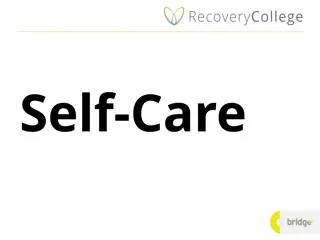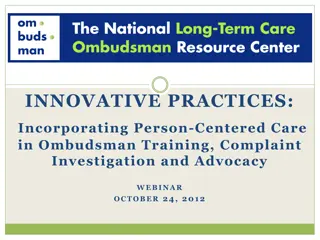Tips for Creating a Self-Care Culture
Learn how to implement and sustain self-care practices amidst challenges. Discover strategies to overcome obstacles, involve others in your self-care routine, and maintain a balanced, enjoyable approach to well-being.
Download Presentation

Please find below an Image/Link to download the presentation.
The content on the website is provided AS IS for your information and personal use only. It may not be sold, licensed, or shared on other websites without obtaining consent from the author.If you encounter any issues during the download, it is possible that the publisher has removed the file from their server.
You are allowed to download the files provided on this website for personal or commercial use, subject to the condition that they are used lawfully. All files are the property of their respective owners.
The content on the website is provided AS IS for your information and personal use only. It may not be sold, licensed, or shared on other websites without obtaining consent from the author.
E N D
Presentation Transcript
Self-care and Resilience in Challenging Times Part Four: Creating a Culture of Self-Care and Implementing Your Self-Care Plan Now Jeffrey E. Barnett, Psy.D., ABPP LCAS Dean s Office January 28, 2021
Implementing Your Self- Care Plan Consider your likely obstacles to implementing and sticking with your self-care plan. Make a list. For each potential obstacle, come up with a plan to address it. Start small, set realistic goals, and celebrate little victories . Work with a self-care buddy or group. Support each other and do self-care together. Make self-care public. Don t keep it a secret; this includes progress, victories, challenges, and difficulties. Keep in mind that we are each human, impirFect, and a work in progress.
Implementation (Cont.) Self-care is a lifestyle, not a goal to be achieved or a finish line to be crossed. We are never done with self- care. Pace yourself. Select a pace you can comfortably maintain over the long run. Plan on an ultra-marathon, not a sprint. You don t want to burn yourself out. Plan for set-backs and accept them as a normal part of life. Be flexible. As circumstances change, make needed changes to your self-care plan. Mix up your self-care activities. Keep things interesting.
Key Points to Keep in Mind Be open to trying new things. Watch out for falling into a rut. Self-care should not feel like a burden. Look for activities that are relaxing, enjoyable, and/or rejuvenating for you. Try to make self-care fun! Strive for balance at work, at home, and between the two. Look to integrate others into your self-care when possible. Combine self-care activities when possible.
Promoting Wellbeing and Resilience Promoting Well-being and Resilience: Living a Life with Purpose and Meaning Seeing Your Actions as Valuable and Worthwhile Seeking and Receiving Help and Support When Needed Develop Meaningful and Supportive Relationships Asserting Influence Over Your Work Environment Being Creative and Flexible Experiencing Positive Emotions (and Thoughts!), Having a Positive Outlook, and Taking Positive Actions.
Creating a Culture of Self-Care Reward Self-Care Activities and Actions. Avoid a Culture of Work, Productivity, Sacrifice, and Exhaustion: I worked until midnight last night to get that project completed. I worked all weekend on that project. Instead, Normalize and Brag About Your Self-Care Actions: I don t check e-mails after 6:00pm. We hiked all day Saturday.
Changing Your Attitude Don t Praise or Value Sending and Receiving E-mails Late at Night and Early in the Morning. Schedule Breaks During the Workday; Remember Lunch Hour (even if it is to take a walk, go to the fitness center, catch up with a friend, etc.). Remember That It is Not a Contest to See Who Works Harder or More Hours. It s About Getting the Work Done Well While Living With Your Life in Balance.
Developing a Culture of Self-Care Include Everyone in Your Work Setting or Work Unit in the Process. Talk About This Openly. Leadership Comes From All Sources: The Top, The Bottom, The Middle. We are Each Role Models for Those Around Us. Hold Supervisors Accountable. Request needed changes. Start Meetings With Regular Self-Care Check-Ins. Supervisors and Leaders Can Share Concerns and Offer Support in Private When Needed. Create a Supportive Work Environment. See the Bigger Picture and Long-Term Benefits. Happy and Healthy Workers are More Productive!
Questions to Consider How have you been practicing self-care? What obstacles and barriers have you faced? Are you feeling isolated or unsupported at work? At home? Do you find yourself thinking negative and self-defeating thoughts? How can you add meaning to your work and to your life? What has helped you?
Additional Questions Is your work environment supportive of self-care? Do you feel cared about as a person? What changes in your work environment would you like to see? Can you and co-workers speak with a unified voice? Who should you speak with at work? Beyond your immediate supervisor, are there groups that might be helpful (Staff Council, Faculty Affairs Committee, others)?
Additional Questions (cont.) Have your efforts to create a culture of self-care in the work setting been successful or unsuccessful? What have you tried and what have you learned from the process? Have you learned anything new in this webinar series? Have you tried anything new? Are you making progress? What are the next steps for you in this process?
Thank You! JBarnett@Loyola.edu























